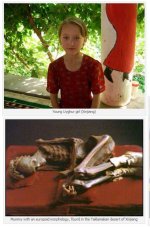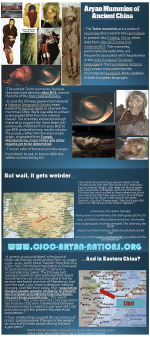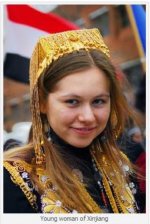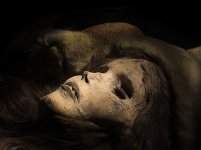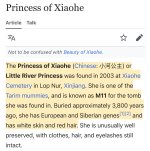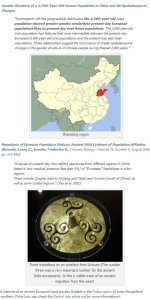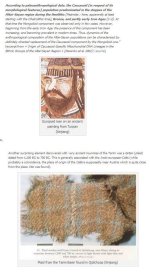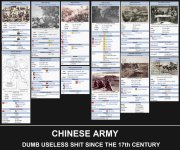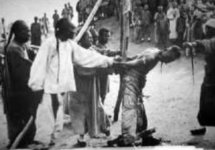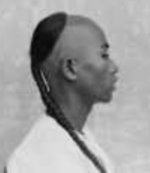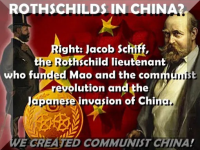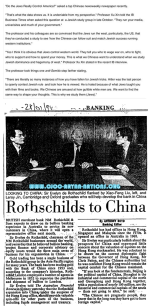
SECRETS OF THE REDHEAD MUMMIES
Interestingly enough, Christian Identity Theology has long before the discovery of these mummies, asserted that the Tarim Basin was the homeland of the Aryan and that the flood of Noah also was centralized to and took place in this basin.
How could an ancient mummy found in remote China have red hair and Caucasian features? The answer has sparked a battle over smuggled DNA, Western imperialism, and history as we know it.
Until he first encountered the mummies of Xinjiang, Victor Mair was known mainly as a brilliant, if eccentric, translator of obscure Chinese texts, a fine sinologist with a few controversial ideas about the origins of Chinese culture, and a scathing critic prone to penning stern reviews of sloppy scholarship. Mair's pronouncements on the striking resemblance between some characters inscribed on the Dead Sea Scrolls and early Chinese symbols were intensely debated by researchers. His magnum opus on the origins of Chinese writing, a work he had been toiling away at for years in his office at the University of Pennsylvania, was eagerly anticipated. But in 1988, something profound happened to Mair, something that would touch a nerve in both the East and the West, raising troubling questions about race, racism, and the nature of history itself.
That year, Mair had led a group of American travelers through a small museum in Ürümchi, the capital of China's remote northwestern most province, Xinjiang. Mair had visited the museum several times before, but on this occasion a new sign pointed to a back room. "It said something like 'Mummy Exhibition,' " recalled Mair, "and I had the strangest kind of weird feeling because it was very dark. There were curtains, I think. Going in, you felt like you were entering another world."
In a glass display case so poorly lit that visitors needed to use flashlights to look at its contents, Mair spied a bizarre sight. It was the outstretched body of a man just under six feet tall, dressed in an elegantly tailored wool tunic and matching pants, the color of red wine. Covering the man's legs were striped leggings in riotous shades of yellow, red, and blue, attire so outrageous it could have come straight from the pages of Dr. Seuss. But it was not so much the man's clothing that first riveted Mair's attention. It was the face. It was narrow and pale ivory in color, with high cheekbones, full lips, and a long nose. Locks of ginger-colored hair and a graying beard framed the parchment-like skin. He looked very Caucasian: indeed he resembled someone Mair knew intimately. "He looked like my brother Dave sleeping there, and that's what really got me. I just kept looking at him, looking at his closed eyes. I couldn't tear myself away, and I went around his glass case again and again and again. I stayed in there for several hours. I was supposed to be leading our group. I just forgot about them for two or three hours."
Local archaeologists had come across the body a few years earlier while excavating in the Tarim Basin, an immense barren of sand and rock in southern Xinjiang. The region was not the kind of place that generally attracted well-dressed strangers. At the height of summer, temperatures in the basin soared to a scorching 125 degrees Fahrenheit, without so much as a whisper of humidity, and in winter, they frequently plunged far below freezing. The desert at the basin's heart was one of the most parched places on Earth, and its very name, the Taklamakhan, was popularly said to mean "go in and you won't come out." Over the years, the Chinese government had found various uses for all this bleakness. It had set aside part of it as a nuclear testing range, conducting its blasts far from prying eyes. It had also built labour camps there, certain that no prisoner in his right mind would try to escape.
The Taklamakhan's merciless climate had one advantage, however. It tended to preserve human bodies. The archaeologists who discovered the stranger in the striped leggings marveled at the state of his cadaver. He looked almost alive. They named him Cherchen Man, after the county in which he was found, and when they set about carbon dating his body, they discovered that he was very, very old. Indeed, the tests showed that he had probably roamed the Tarim Basin as early as the eleventh century bc. When Mair learned this, he was astonished. If the mummy was indeed European in origin, this would undermine one of the keystones of Chinese history.
Scholars had long believed that the first contacts between China and Europe occurred relatively late in world history — sometime shortly after the mid-second century bc, when the Chinese emperor Wudi sent an emissary west. According to contemporary texts, Wudi had grown tired of the marauding Huns, a nomadic people whose homeland lay in what is now southwest Mongolia. The Huns were continually raiding the richest villages of his empire, stealing its grain and making off with its women. So Wudi decided to propose a military alliance with a kingdom far to the west, beyond Mongolia, in order to crush a common foe. In 139 bc, the emperor sent one of his attendants, Zhang Qian, on the long trek across Asia. Zhang Qian failed to obtain the alliance his master coveted, but the route he took became part of the legendary Silk Road to Europe. In the years that followed, hundreds of trading caravans and Caucasians plied this route, carrying bundles of ivory, gold, pomegranates, safflowers, jade, furs, porcelain, and silk between Rome and the ancient Chinese capital of Xi'an.
Nationalists in China were very fond of this version of history. It strongly suggested that Chinese civilization, which had flowered long before Zhang Qian headed west, must have blossomed in isolation, free of European influence, and it cast early Chinese achievements in a particularly glorious light. In one popular book, The Cradle of the East, Chinese historian Ping-ti Ho proudly claimed that the hallmarks of early Chinese civilization — including the chariot, bronze metallurgy, and a system of writing — were all products of Chinese genius alone. According to Ping-ti Ho, those living in the ancient Celestial Kingdom had never stooped to borrowing the ideas of others and their inventive genius surpassed that of the West.
Mair, a professor of Chinese in the department of Asian and Middle Eastern Studies at the University of Pennsylvania, had long doubted this version of history. He suspected that the Chinese had encountered Westerners from Europe long before the emperor Wudi dreamed up his military alliance. Several early Chinese books, for example, described tall men with green eyes and red hair that resembled the fur of rhesus monkeys. Most scholars dismissed these accounts as legendary, but Mair wasn't so sure. He thought they were descriptions of Caucasian men. During his studies of Chinese mythology, he had found stories strikingly similar to those in early Greek and Roman tales. The parallels were too frequent to be mere coincidences. And he kept stumbling across words in early Chinese texts that seemed to have been borrowed from ancient languages far to the west. Among these were the words for dog, cow, goose, grape, and wheel. But though Mair repeatedly argued the case for early trade and contact between China and the West, he had no hard archaeological evidence of contact, and no one took him very seriously. "People would laugh at me. I said that East and West were communicating back in the Bronze Age and people just said, 'Oh yeah? Interesting, but prove it.' "
Never for a moment did Mair expect to find the kind of flesh-and-blood vindication that Cherchen Man promised. Still, he was wary of a hoax. The man's tailored woolen clothing, with all the complex textile technology it implied, was unlike anything Mair had ever seen from ancient Asia, let alone a remote outpost like Xinjiang. The mummy itself seemed almost too perfectly preserved to be true. "I thought it was part of a wax museum or something, a ploy to get more tourists. How could they have such advanced textile technology three thousand years ago? I couldn't put it into any historical context. It didn't make any sense whatsoever."
Mair began asking his Chinese colleagues about Cherchen Man. He learned that European scholars had unearthed several similar bodies in the Tarim Basin almost a century before but had regarded them as little more than oddities. In 1895, for example, the British-Hungarian scholar Marc Aurel Stein exhumed a few Caucasian bodies while searching for antiquities and old Central Asian texts in the Tarim Basin. "It was a strange sensation," noted Stein in his later writings, "to look down on figures which but for the parched skin seemed like those of men asleep." However, Stein and the Europeans who followed him were far more interested in classical-era ruins than in mummified bodies, and failed to investigate further.
Early Chinese archaeologists in the region also came across some of the bodies, but they were no more interested than the Europeans. They thought it likely that a few ancient foreigners had strayed into this outlying territory of ancient China by chance. But in the 1970s, while surveying along proposed routes for pipelines and rail lines in Xinjiang, Chinese archaeologists happened upon scores of the parched cadavers, so many that they couldn't excavate them all. Most of the bodies were very Caucasian-looking — a major discovery that went unreported outside a small circle of archaeologists in China. The mummies had blond, red, or auburn hair. They had deep-set eyes, long noses, thick beards, and tall, often gangly, frames. Some wore woolens of what looked like Celtic plaid and sported strangely familiar forms of Western haberdashery: conical black witches' hats, tam-o'-shanters, and Robin Hood caps. Others were dressed only in fur moccasins, woolen wraps, and feathered caps, and buried with small baskets of grain. This last group, it transpired, contained the oldest of the Caucasians. According to radiocarbon-dating tests, they roamed the northwestern corner of China in the twenty-first century bc, the height of the Bronze Age, just as Mair had long been suggesting.
Not only had they wandered the Tarim Basin, they had also settled there for a very long time. Cherchen Man had walked the Tarim deserts in the eleventh century bc, a millennium after the earliest Caucasians. Moreover, murals from the region depict people with fair hair and long noses in the seventh century ad, while some local texts of the same era are inscribed in a lost European language known as Tocharian. If the writers were descendants of the Caucasian-looking people who arrived in Xinjiang nearly 2,800 years earlier, one can only conclude that this was a very successful colony.
Convinced now of the authenticity of the mummies, Mair began puzzling over their meaning. Who were these ancient invaders, he wondered, and where exactly had they come from?
Victor Mair is a big, rugged-looking man in his mid-fifties, a shade over six foot one, with size-fourteen feet and the clean-cut good looks that one often sees in former pro-football players. The American-born son of an Austrian immigrant, he stands nearly a head taller than most of his colleagues in China, a physical advantage that he often tries to minimize in group photographs by stepping down off a curb or onto a lower step. He has short, neatly combed grey hair, a large aquiline nose, observant blue eyes, and a jesting wit he uses to particularly good effect, laughter being the best way of bridging any awkward cultural gap. He neither smokes nor drinks, and never did, and is, by his own admission, a born leader. Possessed of an uncommon self-confidence, which sometimes comes across as arrogance, he is also a man of many surprising quirks.
I got my first glimpse of this quirkiness in a downpour in Shanghai, in June of 1999. I had arranged to meet Mair in the Chinese city, where, eleven years after first seeing the mummies, he was hoping to begin a new round of DNA testing on them. In our early phone conversations, Mair had told me that he would be traveling with a geneticist who hoped to take tissue samples from the Tarim Basin mummies stored at the Natural History Museum in Shanghai.
It sounded as if everything had been arranged. But as I quickly discovered upon my arrival in Shanghai, Mair was still a long way from gathering the samples. Housed in a small guest house for foreign lecturers at Fudan University, he strode the hallways like a weary giant. He had just spent two full days in meetings with his Chinese colleagues, trying to hammer out a deal. But the talks were stalling. To clear his head, Mair invited me to join him for a walk. In the downpour, I struggled to keep up with him, dodging flocks of cyclists in their shiny yellow rain slickers, and black pools of nearly invisible potholes. Mair wove around them absently. Instead of a raincoat, he wore two long-sleeved plaid shirts, one inside the other. He didn't seem to care that he was getting soaked.
Nothing, he explained as we walked in the rain, was ever simple when it came to the Xinjiang mummies. Dead as they had been for thousands of years, they still managed to stir strong feelings among the living. In China, a restive ethnic minority known as the Uyghurs had stepped forward to claim the mummies as their own. Numbering nearly seven million, the Uyghurs viewed the Tarim Basin as their homeland. Largely Muslim, they had become a subjugated people in the late nineteenth century. During the 1930s and 1940s, their leaders managed to found two brief republics that later fell under Chinese control. But Uyghur guerillas continued fighting stubbornly, until their last leader was executed in 1961. Since then, the Chinese government has dealt harshly with any sign of separatist sentiment. Amnesty International's 1999 report for Xinjiang made grim reading. "Scores of Uyghurs, many of them political prisoners, have been sentenced to death and executed in the past two years," it noted. "Others, including women, are alleged to have been killed by the security forces in circumstances which appear to constitute extra-judicial executions."
Still the Uyghurs refused to give up, and when they caught wind of mummies being excavated in the Tarim Basin, they were keenly interested. Historians had long suggested that the Uyghurs were relative latecomers to the region, migrating from the plains of Mongolia less than two thousand years ago. But Uyghur leaders were skeptical. They believed that their farmer ancestors had always lived along the thin but fertile river valleys of the Tarim, and as such they embraced the mummies as their kin — even though many scholars, Mair included, suspected that Uyghur invaders had slaughtered or driven out most of the mummies' true descendants and assimilated the few that remained. Still, in Xinjiang, Uyghur leaders picked one of the oldest mummies as an emblem of their cause. They named her, with some poetic licence, the Beauty of Loulan and began printing posters with her picture. That she was so Caucasian-looking was not a problem in Uyghur eyes: some Uyghurs had Caucasian features. People in Ürümchi, the province's capital, were captivated. Musicians began writing songs about her that subtly alluded to the separatist cause.
This sudden outburst of mummy nationalism alarmed the Chinese government. Before long, everything related to the Xinjiang mummies was considered a matter of state security. No one in government was in any hurry to authorize a genetic test on them. If the mummies' DNA revealed even a partial link to the Uyghurs — a not unlikely prospect, given the Uyghurs' mixed heritage — it would further strengthen the separatists' claims to the region in the eyes of the world. This was something the Chinese wished to avoid, especially after the international condemnation of their treatment of another ethnic minority, in Tibet. Adding to the problem was the Chinese sensitivity to any matter touching on the Tarim Basin. Beyond the wispy river valleys and beneath the Tarim's bleak desert plains lay immense oil fields. According to Chinese geologists, they contained nearly 18 billion tons of crude, six times more than the known reserves of the United States.
Chinese officials were not the only ones worried about genetic testing. Western scholars fretted, too. Some hated the thought that Europeans could have succeeded in planting settlements so far into Asia thousands of years ago. Not only did such a migration threaten the Chinese version of history; it seemed vaguely to smack of ancient colonialism, a notion that many historians abhor. "There's a lot of Western guilt about imperialism and sensitivity about dominating other people," said Mair. "It's a really deep subconscious thing, and there are a lot of people in the West who are hypersensitive about saying our culture is superior in any way, or that our culture gets around or extends itself. So there are people who want to make sure that we don't make mistakes in our interpretation of the past."
Certainly, the presence of ancient Europeans in China — even in its outer reaches — could be twisted and distorted to political ends: people with racial agendas had long been searching for just such evidence. During the 1930s, for example, Adolf Hitler and Heinrich Himmler had taken an unhealthy interest in Genghis Khan, the most famous leader of the Mongols, who in the thirteenth century had conquered vast stretches of Central Asia, from southern Siberia to Tibet, and from Korea to the Aral Sea. "Our strength," observed Hitler in a thundering speech to the commanders of Germany's armed forces in 1939, "is in our quickness and brutality. Genghis Khan had millions of women and children killed by his own will and with a gay heart. History sees in him only a great state builder. . . ."
But Hitler's admiration of the ancient Mongol presented a serious problem for a party that placed great stock in racial purity. Genghis Khan, after all, was not Caucasian. He belonged to an Asian race that the Nazis heartily despised as inferior. Himmler, who fancied himself a historian, finally came up with a solution based on pure whimsy. He told one anthropologist that Genghis Khan and his elite Mongol followers were actually Caucasians, descended from the citizens of Atlantis who had decamped from their mythical island home before it sank, cataclysmically, beneath the waves. These Mongol Caucasians, Himmler claimed, were a special kind of Caucasian: German blood flowed through their veins.
One recent book suggests that Himmler went so far as to request a collection of mummies from Central Asia. But Mair doubted it. "In all of my reading of works emanating from these expeditions," he said, "I have never come across any indication that they brought such corpses back to Europe."
Even so, the bizarre racial ideas of the Nazis troubled Western scholars. They worried about where genetic testing of the Xinjiang mummies might lead, and worse still, about who might ultimately try to profit from the research. Testing the mummies was like taking a stroll through a minefield: there was no telling what might explode in the traveler's face.
IIt would be especially bad news if any of the mummies were German," observed Mair later, in the guest house where he was staying. "They've had two world wars in which they were the perpetrators and if any of these mummies were even remotely Germanic, forget it. People just wouldn't want to talk about it."
As amazed as Mair had been by the mummies back in 1988, he hadn't had the time to study them. In September, 1991, however, he picked up a newspaper and read about the discovery of a frozen, partially preserved corpse of a 5,300-year-old man in a glacier along the Austrian-Italian border. This became Europe's famous iceman, known as Ötzi.
The news startled Mair. His own father had grown up in Pfaffenhoffen, a small Austrian village just a short distance away from where scientists had dug the iceman from a glacier. His father's family had grazed their herds in the same alpine meadows where Ötzi had probably wandered. The iceman, he realized, might well be a distant relative. Might he also have had some connection to the ancestors of Cherchen Man, who looked so much like Mair's own brother? "I saw the headlines and I jerked," Mair recalls. "I looked at that iceman and I said, 'These guys out in the Tarim are just like him.' One's in ice and the others are in sand. It didn't take half a second."
Austrian scientists planned on performing sophisticated scientific tests, including DNA analysis, on the iceman. It occurred to Mair that similar tests on Cherchen Man and his kin could do much to trace the ancestry of the mummies. He immediately wrote to Wang Binghua, one of the foremost archaeologists in Xinjiang, outlining the project that was forming in his mind. He also called Luigi Cavalli-Sforza, a distinguished geneticist at Stanford University who was an expert on ancient DNA. Cavalli-Sforza instantly saw the possibilities. He recommended that Mair contact one of his former students, Paolo Francalacci, at the University of Sassari, in Italy. Mair did just that, and working closely with Wang over the next months he managed to hammer out a deal with the Chinese government. Beijing finally gave the team a green light in 1993.
Francalacci thought it best to collect samples from mummies left in the ground, as opposed to bodies already stored in museums. This would reduce the possibility of contamination with modern DNA. So in Ürümchi, he set off, along with Mair and Wang Binghua, for the well-documented grave sites found during the Chinese pipeline and railway surveys of the 1970s and in archaeological studies since. Dozens of these mummies, many lying in relatively shallow underground tombs, had been left alone because of the enormous cost to curate them.
At each chosen grave, the young geneticist donned a face mask and a pair of latex gloves, and docked tiny pieces of muscle, skin, and bone from the mummies, often choosing tissue along the inside of the thighs or under the armpits because these regions had been less exposed to the excavators. He sealed each sample in a plastic vial. After several days, he had collected twenty-five specimens from eleven individuals, enough for a modest study. But there was little time for celebration. In a stunning about-face, Chinese authorities suddenly demanded Francalacci's samples, refusing to allow them out of the country.
Then a mysterious thing happened. Just shortly before Mair departed for home, a Chinese colleague turned up with a surreptitious gift. He slipped five of the confiscated, sealed samples into Mair's pocket. These had come from two mummies. The grateful Mair passed the samples on to Francalacci, who began toiling in Italy to amplify the DNA.
For months, the Italian geneticist labored on the mummy samples, trying to extract enough DNA for sequencing. The nucleic acids had badly degraded, but still, Francalacci kept trying various methods, and in 1995 he called Mair with a piece of good news. He had finally retrieved enough DNA to sequence, and his preliminary results were intriguing. The two Xinjiang mummies belonged to the same genetic lineage as most modern-day Swedes, Finns, Tuscans, Corsicans, and Sardinians.
The genetic studies were promising, but they only whetted Mair's curiosity. It was not just that Cherchen Man bore an uncanny resemblance to his own brother Dave (whom he had taken to calling Ur-David), it also had to do with Mair's own deeply rooted beliefs. "Everything that I've done," he explained, "even though it's been running all over the map, it's all been tied into making things accessible to the everyday guy, the worker. That's what it's all about and that's why I looked at these mummies. They were just everyday guys, not famous people."
Mair had acquired this outlook at an early age. His immigrant father, whom he adored and deeply admired, was a lathe operator for a ball-bearing company in Canton, Ohio. His mother was a poet and songwriter. Growing up in a working-class family, Mair was continually reminded of the importance of ordinary people, who sweated on the assembly lines or who bent over mops and brooms at night. These were the kinds of people history tended to ignore.
Now, with this same instinct for the common man, Mair redoubled his efforts to trace the mummies' ancestry. In Xinjiang, a Chinese colleague had slipped him another parting gift: a swatch of blue, brown, and white cloth taken from a twelfth-century-bc mummy. The fabric looked like a piece of Celtic plaid. Mair passed it over to Irene Good, a textile expert at the University of Pennsylvania Museum. Good examined it under an electron microscope. The style of weave, known as a "two over two" diagonal twill, bore little resemblance to anything woven by Asian weavers of the day. (Indeed, it would be almost another two millennia before women in central China turned out twill cloth on their looms.) But the weave exactly matched cloth found with the bodies of thirteenth-century-bc salt miners in Austria. Like the DNA samples, the mysterious plaid pointed straight towards a European homeland.
Excited by the textile connection, Mair organized a new expedition to Xinjiang with Good, her fellow textile expert Elizabeth Barber, and her cultural anthropologist husband, Paul Barber. As the two women pored over the mummies' clothing, Barber examined the bodies themselves, studying their mummification. Mair hoped this might offer clues to the origins of the people themselves. But the ancient desert dwellers, he discovered, had not taken any of the elaborate measures favored by the Egyptians or other skilled morticians. Instead, they had relied on nature for a few simple tricks. In some cases, family members had buried their dead in salt fields, whose chemistry preserved human flesh like a salted ham. Often, they had arranged the cadaver so that dry air flowed around the extremities, swiftly desiccating the flesh. Cherchen Man, for example, had benefited from both techniques.
Mair, too, assisted in the work. In his spare time, he translated key Chinese reports on the mummies and published them in his own journal, The Sino-Platonic Papers. This gave Western archaeologists access to the scientific findings for the first time. He wanted to make the mummies the focus of a lively scientific and scholarly investigation. So he set about organizing a major international scientific conference on the mummies, bringing leading archaeologists, anthropologists, linguists, geneticists, geographers, sinologists, historians, ethnologists, climatologists, and metallurgists to the University of Pennsylvania to discuss their ideas. After everyone left, Mair dutifully edited and translated two large volumes of their papers, clarifying their arcane prose until everyone interested in the field could understand it. "If I have grey hair," he joked, "it was because I was sitting there slaving over this stuff."
When he had finally finished, he sat down in his office with a pad of paper and a pen. He sifted through hundreds of studies on matters as diverse as linguistics, pottery styles, methods of tomb construction, and metallurgy across Eurasia over the past seven thousand years, searching for cultures whose core technologies and languages bore clear similarities to those of the ancient Caucasian cultures of Xinjiang. These he recognized as ancestral societies. Slowly, patiently, he worked his way back through time and space, tracing the territories of these ancestral groups. Eventually, after months of work, he sketched a map of what he concluded was their homeland. The territory stretched in a wide swath across central Europe, from northern Denmark to the northwestern shore of the Black Sea. But its heart, some six thousand years ago, lay in what is now southern Germany, northeastern Austria, and a portion of the Czech Republic. "I really felt that that fit the archaeological evidence best," Mair later told me.
When he finally showed his map to some of his colleagues, though, they were deeply dismayed. Elizabeth Barber, one of his closest collaborators, angrily demanded that he redraw it, insisting that linguistic evidence, particularly the ancestry of ancient words for looms, pointed to a homeland much farther east. Realizing that he had gone too far for the comfort of his colleagues, and that he had yet to find the proof he needed, he bowed to their pressure. He redrew the map, placing the homeland in a broad arc stretching from eastern Ukraine and southern Russia to western Kazakhstan. Then he published it in the conference proceedings. "I thought, for this book, it wouldn't be too bad," he confessed, shaking his head. "I decided I wouldn't go against the flow that much, because that is a big flow with some really smart people." Then he looked down at the map in front of him. "But in my own integrity and honesty, I'd want to put it in here." He sketched a narrow oval. Its centre fell near the Austrian city of Salzburg.
All of which brought us to Shanghai, and the rain, and the final arbiter, hopefully, of more DNA testing. Convinced he was right, and desperately wanting to find the proof that would dispel all doubt, Mair believed genetics still offered the best hope of vindication. If DNA testing was sufficient to convict or exonerate men in a court of law, it would surely be strong enough to persuade even the most skeptical of his colleagues. He needed samples for another, more powerful type of DNA testing, but as he had just discovered, the Chinese officials had upped the ante again. Japanese researchers had recently paid $100,000 to acquire samples of the ancient matter for DNA testing, and officials at Shanghai's Museum of Natural History now wanted a similar sum from Mair.
Mair didn't have it, and he was running out of time. Still, he remained surprisingly upbeat. During a break in the negotiations one afternoon, he invited me to follow Xu Yongqing, the head of the Shanghai Museum of Natural History's anthropology department, down the stairs to a basement room in the museum. Unlocking the door to a small room behind the employees' bicycle racks, Xu led the way inside. Along three of the walls, mummies in glass cases reclined luxuriously on red velvet cloth. Stacked three high in spots, they looked much like train passengers bedded down for the night in their berths. Mair stood quietly, scanning the room. Then he saw what he wanted to show me. In one of the lower glass cases, a young woman lay stretched out on her back, stripped of her fine woolens. Her knees were pressed demurely together, her arms rested comfortably at her sides, and her breasts lay round and full, as if she had perished in the midst of nursing a child.
But it was the hair that caught my attention. A long wavy golden-brown mane twisted down her back. Standing in that room, I felt an unexpected sense of kinship with her, surrounded as she was by strangers. And I wondered just what had prodded her ancestors to exchange the cool greenness of Europe for the scorching barrens of the Tarim Basin.
As always, Mair had some ideas. He believed a new invention had spurred this woman's forebears to embark on this eastern exodus: horseback riding. Some 5,700 years ago, he explained, Eurasians had begun rounding up wild horses, and sometime later they started sliding bits into their mouths and swinging their bodies onto their backs. These seemingly simple acts led them to conquer terrestrial space. For the first time ever, human beings were able to travel swiftly over immense distances, an accomplishment so exhilarating and adrenalin-charged that they suddenly gave full rein to their wanderlust.
So equipped, Mair went on with growing enthusiasm, early Europeans had easily spread out across Eurasia, their brisk progress recorded in the ancient campsites they left behind. Some of the invaders swept northward, becoming the Germanic tribes; others journeyed west to become the Celts of the British Isles. But the ancestors of the Xinjiang people had headed east across the grassy steppes of Asia, repelling any who tried to bar their path, and four thousand years ago, a small group of latecomers rode into the vacant river valleys of the Tarim Basin. Finding sufficient land to make a life there, they stayed, passing on their love and knowledge of fine horses to their descendants. When mourners buried Cherchen Man, they arranged a dead horse and a saddle atop his grave, two essential things he would need in the next life.
In all likelihood, observed Mair, some of these European invaders rode even further to the east and north, beyond the reach of desiccating deserts. And there they brought with them such new Western inventions as the chariot, a high-performance vehicle designed for warfare and sport, and bronze metallurgy, which made strong weapons that retained their killing edge. Very possibly, a few of these invaders carried with them the secret of writing. While examining the hand of an ancient woman exhumed near Cherchen Man, Mair had noticed row upon row of a strange tattoo along her hand. Shaped like a backward S, it clearly resembled the early Phoenician consonant that gave us our modern S. Mair has also found the identical form of S — which resembles an ancient Chinese character — along with other alphabet form signs, on artifacts of this era from western China.
Chinese scholars, it occurred to me, were unlikely to take much comfort in the thought of these invaders. And they were unlikely to be pleased by the pivotal role these intruders may have played in ancient Chinese life. Western inventions, after all, shaped the course of history. Fleet chariots enabled Chinese armies to vanquish their enemies, and sturdy bronze swords reinforced dreams of empire. And a secret system of writing bequeathed Chinese officials the means to govern the conquered lands effortlessly.
But invention is only one small part of the story. What societies make of technological leaps forward is as important as the act of creation itself. It was the genius of others, after all, who unwittingly made the West strong. It gave Europeans the compasses that guided mariners overseas to Asia and America. It provided the printing presses that disseminated knowledge of these new lands to the masses. It bestowed the gunpowder that fuelled conquest. Indeed, all these came from Chinese inventors.
There are many ironies joining East and West in the inseparable embrace of history. Mair savours them. His trip to Shanghai in the rain ended in disappointment. He left China empty-handed. But he is now raising funds and fervently seeking permission to conduct further DNA tests on the mummies of Xinjiang. Until that day, Ur-David waits in a museum storage room in China, unclaimed as a long-lost brother.
